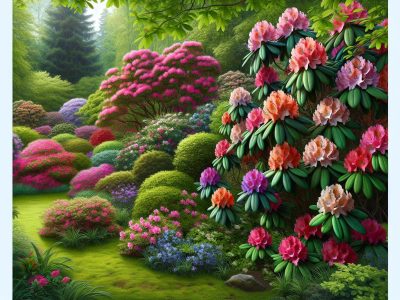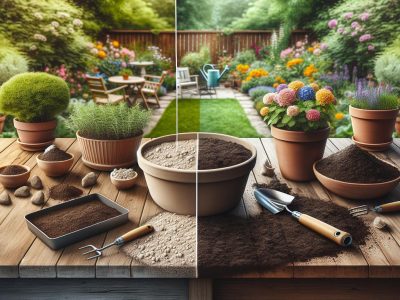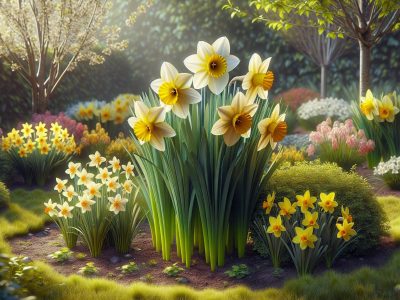Understanding the Difference Between Azalea and Rhododendron: A Gardener’s Guide
Imagine wandering through a garden, enveloped by a world of vibrant blooms and lush greenery. Among the dazzling array, two stunning plants often catch your eye: azaleas and rhododendrons. Their kaleidoscope of colors and captivating fragrances beckon you closer, yet their similarities can leave you wondering about their true identities. While they share the same botanical family, these floral wonders possess distinct characteristics that set them apart.
As you investigate deeper into their world, you’ll uncover surprising differences that could transform your gardening experience. From the subtle nuances in their leaves to the unique conditions they thrive in, understanding these distinctions can enhance your appreciation and care for these plants. Whether you’re a seasoned gardener or a curious enthusiast, exploring the contrasts between azaleas and rhododendrons will unlock a new level of botanical knowledge, enriching your garden with beauty and diversity.
Overview of Azaleas and Rhododendrons
Azaleas and rhododendrons belong to the Ericaceae family, sharing vibrant colors and enticing fragrances. Their beauty is captivating, though it’s easy to confuse them due to their similarities. Azaleas, with their smaller, funnel-shaped flowers, often bloom in early spring. Rhododendrons, but, typically showcase their bell-shaped blossoms in late spring, offering a more extended presence in garden landscapes.
Azaleas usually have smaller, thinner leaves covered with tiny hairs, which can feel soft to the touch. These leaves often turn reddish in the fall, providing seasonal interest beyond their flowering period. Rhododendrons possess larger, leathery leaves that remain evergreen in most climates, providing year-round foliage to gardens.
Growing conditions also set these plants apart. Both prefer acidic, well-drained soil, but azaleas generally thrive in filtered sunlight, while rhododendrons can tolerate more shade. The choice of where to plant may impact their growth, especially in regions with varying sun exposure. When selecting either plant, consider your local climate and garden conditions, as adapting their placement can greatly influence their success.
By understanding these differences, you can better decide which plant suits your aesthetic preferences and gardening environment. Remember, a well-planned garden with the right mix of azaleas and rhododendrons can provide colorful, sequential blooms throughout the growing season.
Botanical Differences
Understanding the botanical distinctions between azaleas and rhododendrons enriches your gardening knowledge. These differences encompass various plant characteristics that affect their growth and aesthetics.
Leaf Characteristics
Azaleas have smaller and softer leaves compared to the larger, leathery leaves of rhododendrons. Typically, azalea leaves possess fine hairs and transform to a reddish hue in fall. In contrast, rhododendron leaves are evergreen, maintaining their green color year-round. The structure and texture of the leaves greatly determines the plant’s adaptation to its environment.
Flower Structures
Azaleas exhibit funnel-shaped flowers, often in clusters, creating a striking display during early spring. Rhododendrons develop larger, bell-shaped blossoms, forming clusters that bloom in late spring. This variance in flower structure impacts the plant’s visual appeal and pollinator attraction. Azaleas generally feature five stamens per flower, whereas rhododendrons frequently have ten or more. This stamen distinction adds another layer to the botanical separation between these plants.
Growth Habits
Explore the dynamic growth habits of azaleas and rhododendrons to enhance your garden’s aesthetic appeal. Recognizing their differing tendencies helps you nurture these plants effectively.
Size and Shape
Azaleas generally grow smaller and more compact compared to rhododendrons. Azaleas can form rounded bushes, reaching heights of 2 to 5 feet. This makes them ideal for creating colorful borders or filling in areas of your garden where space are limited. In contrast, rhododendrons often become larger, expanding up to 15 feet tall with a wider spread, offering a dramatic presence in your world. Their robust structure allows them to serve as impressive standalone specimens or backdrop plantings, showcasing their beautiful blossoms.
Preferred Environments
Azaleas thrive in environments offering filtered sunlight, like dappled sunlight beneath tall trees. This allows you to incorporate them into woodland gardens where they harmonize with the natural world. On the other hand, rhododendrons can tolerate more shade, making them suitable for north-facing areas with less direct sunlight. Ensuring optimal soil acidity is crucial for both plants, as they prefer acidic, well-draining soils. Creating slightly raised beds enhances drainage and improves their growing conditions, fostering healthy root development and vigorous growth in your garden.
Seasonal Blooming
Understanding the bloom cycles of azaleas and rhododendrons helps determine the best time to enjoy their vibrant displays in the garden.
Azalea Bloom Cycles
Azaleas delight gardeners with their early spring blooms. These shrubs display a profusion of funnel-shaped flowers, creating a stunning visual impact. Typically, azalea species bloom for 2 to 4 weeks. During this period, their blossoms cover the shrub, offering a vibrant spectacle. Some varieties, such as the evergreen Kurume azaleas, showcase an extended flowering period with sporadic blooming in other seasons. Environmental factors, like temperature and sunlight, influence the timing of azalea blooms.
Rhododendron Bloom Cycles
Rhododendrons produce their showy, bell-shaped flowers from late spring to early summer. Bloom lasting longer compared to azaleas, some rhododendrons extend their display over 6 to 8 weeks. With varieties like the PJM rhododendron, a burst of color can even occur during cooler months. Consistent blooms depend on optimal conditions, including appropriate shade and soil moisture levels, so consider these factors for successful flowering. The diversity in rhododendron bloom times, due to numerous species and hybrids, offers a rich palette for gardeners, allowing for a staggered flowering display throughout the season.
Care and Maintenance
Understanding the care and maintenance of azaleas and rhododendrons ensures healthy growth and beautiful blooms. Both plants share some needs but differ in others, requiring specific care routines.
Soil and Watering Needs
Azaleas and rhododendrons flourish in acidic, well-draining soil rich in organic matter. The soil should have a pH between 4.5 and 6.0. Using peat moss or pine bark as amendments improves soil quality. Proper drainage prevents root rot, which these plants are susceptible to.
Regular watering keeps the soil consistently moist, especially during growth periods. Water the plants deeply rather than frequently to encourage deep root development. Rhododendrons prefer a bit more moisture than azaleas, but overwatering is harmful to both.
Pruning and Fertilization
Pruning azaleas and rhododendrons maintains their shape and promotes new growth. Complete pruning immediately after flowering to avoid cutting off next season’s buds. Remove dead or diseased branches to enhance airflow within the plant.
Fertilize both plants sparingly, using a slow-release, acidic fertilizer formulated for acid-loving plants. Apply fertilizer in early spring when growth begins and avoid fertilizing late in the season to prevent tender growth susceptible to frost damage. Over-fertilization can lead to leaf burn and plant stress, so following the recommended guidelines is crucial.
Popular Varieties
Azaleas and rhododendrons boast numerous captivating species, each with unique features and characteristics. Here are some popular varieties you might consider for your garden.
Notable Azalea Species
- Kurume Azalea: Known for its vibrant blooms, Kurume azaleas offer a spectrum of colors like pink, red, and white. These evergreen shrubs originate in Japan and fit well in small garden spaces due to their compact size.
- Southern Indica Azalea: With its large flowers and robust growth, the Southern Indica azalea thrives in warmer climates. It showcases purple, pink, and white blossoms, making it a favorite in southern landscapes.
- Satsuki Azalea: Satsuki azaleas bloom later than other varieties, usually around May or June, providing a mix of colors, from white to deep magenta. Ideal for bonsai enthusiasts, these azaleas have a unique flowering pattern where multiple hues can appear on a single plant.
- Rhododendron ‘Nova Zembla’: This hardy rhododendron, famous for its bright red flowers and dark green leaves, withstands cold climates well. It serves as a stunning backdrop with its impressive height, often reaching up to 8 feet.
- Rhododendron ‘Cunningham’s White’: Known for its resilience, this variety blooms with elegant white flowers, sometimes tinged with pink. Its adaptability makes it a versatile choice for various garden settings.
- Rhododendron ‘PJ Mezitt’: This hybrid, renowned for its cold-hardiness and early spring blooms, presents lavender-pink flowers. It is commonly used for hedging due to its dense, upright growth habit.
Each species offers unique aesthetics and growth characteristics, enhancing any world. By selecting the right variety, considering your climate and garden size, you ensure a vibrant display of seasonal color.
Conclusion
Understanding the differences between azaleas and rhododendrons can significantly enhance your gardening experience. By recognizing their distinct characteristics and care needs, you can select the right plant for your garden’s aesthetic and environmental conditions. Whether you’re drawn to the compact beauty of azaleas or the grandeur of rhododendrons, both offer stunning displays of color and fragrance. With the right care and planning, you can enjoy a vibrant garden filled with sequential blooms throughout the growing season. Embrace the diversity these plants offer and enrich your garden with their captivating presence.
- Understanding the Difference Between Waterproof and Water Resistant: A Complete Guide - October 22, 2025
- OLED vs QLED: Unraveling the Key Differences for Your Next TV Purchase - October 22, 2025
- Psychologist Versus Psychiatrist: Key Differences to Choose the Right Mental Health Professional - October 22, 2025







